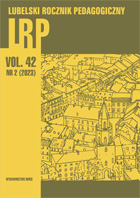ZASTOSOWANIE SKALI NEP DO BADANIA ŚWIADOMOŚCI EKOLOGICZNEJ MŁODZIEŻY AKADEMICKIEJ
AN APPLICATION OF THE NEP SCALE IN STUDYING ENVIRONMENTAL AWARENESS OF ACADEMIC YOUTH
Author(s): Agnieszka Kozłowska, Adrianna Brzezińska, Paulina Dąbrowska, Joanna Kuczora, Aleksandra Jarecka, Joanna Kwaśna, Ewelina Łobodziec, Magdalena KaczmarekSubject(s): Higher Education , Applied Sociology, Environmental interactions, Sociology of Education
Published by: Wydawnictwo Naukowe Uniwersytetu Marii Curie-Sklodowskiej
Keywords: environmental awareness; New Environmental Paradigm; NEP scale; environmental pedagogy; academic youth;
Summary/Abstract: Introduction: Humans’ attitude toward nature, based on the anthropocentric philosophy and belief in human exceptionalism are the root causes of environmental crisis. New Ecological Paradigm (NEP) presumes to step away from anthropocentrism and recognizing the limits to growth, which is based on unsustainable exploitation of the environment. Worldwide, the level of acceptance for NEP is measured by the NEP Scale (New Ecological Paradigm Scale) consi- sting of 12–15 theses, for which answers are expressed in a Likert scale.Research Aim: Using the NEP Scale for examination of academic youth’ senvironmental awa- reness.Method: Online survey including a 15-element NEP Scale translated into Polish was used; for questionnaire and data collecting Qualtrics Survey App was applied. The collected data from among N = 260 students were subjected to ordering, re-coding, and statistical analysis, inclu- ding descriptive statistics, frequencies, and t-test for the NEP index in the groups of genders, using SPSS Statistics 28.0.1.0. Respondents’ support for NEP was estimated by frequency analy- sis of “pro-ecological” responses, comparison of means, and the NEP index.Results: The frequency of responses expressing support for NEP was 74.5; the mean for indivi- dual questions valued from 1 (no support) to 5 (maximum support) was 4.13. The NEP index (scale from 0 to 1) was 0.78. T-test confirmed gender influence on NEP Index, which was higher among women than men (mean 0.79 vs. 0.72), with p = 0.007.Conclusions: The NEP Index values indicate the high environmental awareness of the studied academic youth. Higher support for NEP among women is in line with the worldwide trend observed in numerous studies, in which women’s awareness and behaviour are more pro-eco- logical than men’s
Journal: Lubelski Rocznik Pedagogiczny
- Issue Year: 42/2023
- Issue No: 2
- Page Range: 93-116
- Page Count: 24
- Language: Polish

